All you need to know about Basilica di Santa Maria Maggiore ( Saint Mary Major Basilica ), one of the most significant and stunning churches in Rome, Italy.
Santa Maria Maggiore is one of the four Papal Basilicas in Rome and one of the most significant and beautiful Rome churches.
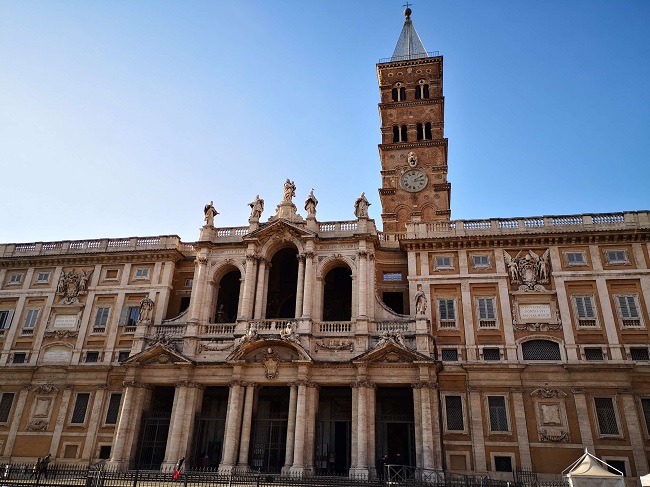
Perched on top of Esquiline Hill, Santa Maria Maggiore has a beautiful facade, stunning ancient mosaics, highly decorated chapels with masterpieces by some of the most influential Rome artists, and it has vast religious significance.
As one of the only four major Papal Basilicas, Santa Maria Maggiore is one of the most significant Catholic Churches in the city and the world.
Visiting Santa Maria Maggiore is a must for religious visitors and art lovers. In this guide, you will find all you need to know to plan a visit to this stunning basilica.
Where is Santa Maria Maggiore Basilica: location and how to get there
Santa Maria Maggiore is on Esquiline Hill, one of the historic seven hills of Rome.
Its Official Name is Basilica Papale di Santa Maria Maggiore but it is most commonly referred to as Santa Maria Maggiore (in English: St Mary Major Basilica)
Admission: free
Opening Hours: 7,00 alle ore 18,45 for visits. You can find mass times here.
The Basilica is only a few minutes walk from Termini station.
The closest metro stop is Termini (all metro lines), and the nearest bus stop is Termini Terminus.
Buses serving this area are: C2, C3, H, M, 16, 38, 40, 64, 75, 82, 85, 90, 92, 105, 170, 175, 217, 310, 360, 649, 714, 910, all departing/finishing at the Termini bus terminus, about five minutes walk from the church.
Access to the basilica is free. Security control check bags but, usually, there is no long queue to enter the church.
Due to the religious significance of the church, appropriate clothing is necessary.
While the dress code is not consistently enforced, you should avoid shorts, short skirts and revealing tops as they may result in you being turned away.
For tips on what to wear to Visit Rome churches, I recommend checking our guide about the Vatican dress code.
It is stricter in the city: abiding by it is the best way to make sure you dress appropriately to enter all Catholic Churches in Rome.
What to see in Santa Maria Maggiore
Santa Maria Maggiore is a church with many works of art, so you can visit it almost like a museum.
Things not to be missed are:
- The bell tower
- The main portico and church doors
- The church mosaics (several cycles, from different times)
- Jesus’ Crib relic
- The Renaissance ceiling
- Several inner chapel by masters of the Renaissance
- Papal graved and grave of Bernini.
Let’s look at them one by one.
Santa Maria Maggiore Bell Tower
As you arrive at Santa Maria Maggiore, you find yourself in front of a beautiful elaborate facade and a striking bell tower.
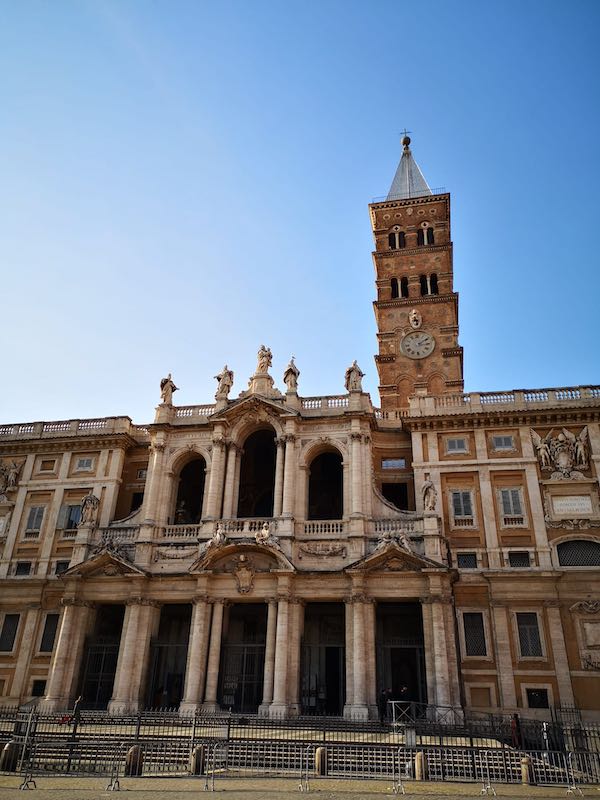
Santa Maria Maggiore’s bell tower is 75mt tall and dates from 1375-1376.
It was built by order of Pope Gregory XI after he moved back from Avignon to Rome but only acquired the appearance we see today over the course of the centuries, with the acquisition of extra height and a clock face.
The bell tower is in Romanesque style and has five bells on top.
Of the five bells, one has a unique role and story. Named ‘La Sperduta’ (lit. the lost one), it tolls every night at nine and is at the center of a local legend.
Local stories from the XVI century tell us that, one day, a girl got lost in the Esquiline area.
According to some sources, she was a Shepard and, according to others, a pilgrim.
The young girl got lost and turned to the Virgin for help in either case. In response to her prayer, the bell towers started to play and she was able to follow their sound back to safety.
The bell still rings today in memory of that event.
The Basilica’s facade
The main facade of the church, as we see it now, dated from the XVII century owes its appearance to architect Ferdinando Fuga from Florence.
The facade, however, hides a secret; to preserve the previous facade, Fuga added its work to the previous one, creating a unique church exterior that develops onto two layers: an external, more rents one, and an older one dating from XIII century.
This is particularly easy to appreciate looking at the area on top of the main church gate and once you step under Santa Maria Maggiore’s portico.
Worth seeing are the two tall statues of the angels guarding the loggia, positioned as if they were peeking in: while not immediately visible, they are a very powerful presence and add a special touch to the whole church’s exterior.
Santa Maria Maggiore’s Portico
As you walk under the central portico, you can admire several masterpieces.
Beautiful mosaics by Cavallini and Rusuti cover the top part of the walls.
They develop over two layers and date from 1297- 1308 and they are among the most beautiful mosaics in Rome.
In typical Byzantine fashion, the main area represents Christ in golden tones against a blue sky; the others represent scenes from the miracle of snow (see below), said to have happened in this exact location.
Santa Maria Maggiore’s doors
The basilica has several doors at its entrance.
The central door dates from 1947: it is by Ludovico Pogliaghi and represents the Virgin, the Evangelists and several women from in the Old Testament.
On the left is the Sacred Door (Porta Sacra), blessed by Pope John Paul II in 2001.
The door is elaborately decorated.
On it, we can see a representation of the Risen Christ; on the top left there is a representation of the Annunciation; on the low part of the door, the Ephesus Council, which declared Mary as Theotokos, and the Council Vatican II, which recognized her Mater Ecclesiae.
The Papal sign of John Paul the II is also visible.
Santa Maria Maggiore central nave
As you walk inside the church, the first thing you notice is how vast the area is. Santa Maria Maggiore is huge: a central nave leads to the main altar, while two smaller side naves open onto several side chapels.
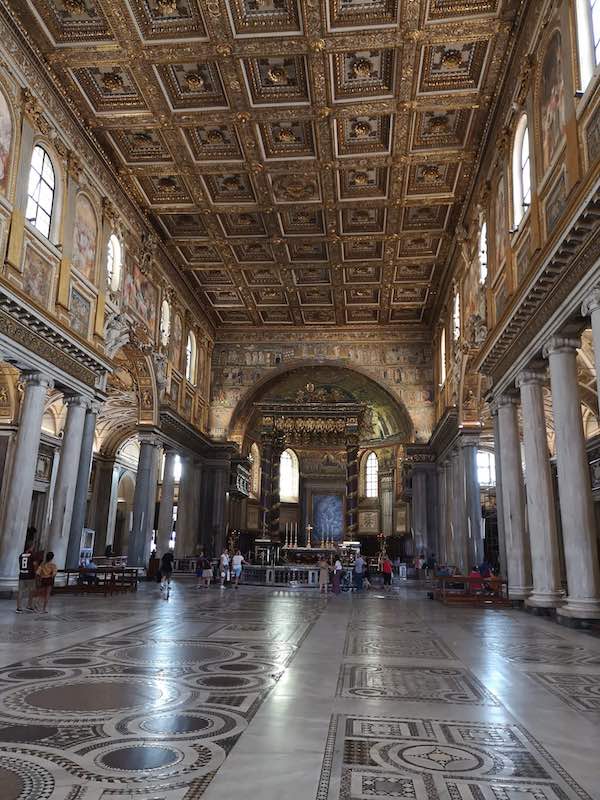
The church rose above a more ancient structure, little of which remains, and has a classical, grand appearance yet a plan that still retains its paleo-Christian origins (read below the legend connected to the church’s birth!).
Santa Maria Maggiore is the only one of the four Patriarchal Basilicas in Rome to have retained its paleo-Christian plan.
The central nave is flanked by two series of columns in the Ionic style, typical of classic architecture.
It has an elaborate ceiling decorated with the first gold that came to Rome from the Americas!
The ceiling dates from the Renaissance: its author is Giuliano da Sangallo, who used gold and blue, which is also an element of the coat of arms of the Borgia Family.
The mosaics
The mosaics inside Santa Maria Maggiore are among the most important mosaics in Rome and a unique example of an ‘impressionist mosaic’.
This expression describes a type of mosaic that uses colorful, often imperfect tiles and that evoke an impression of a scene, a little like, much later, the paintings of Impressionist masters.
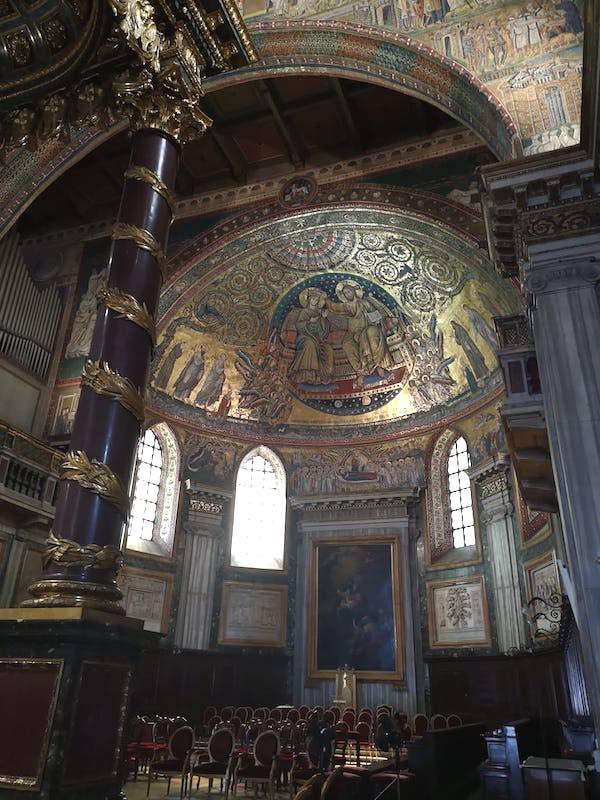
They date back to the early days of the basilica, and they are stunning and significant in art history.
Furthermore, they are the first example in Rome of mosaics with both a decorative and educational meaning.
The mosaics represent the Sacred Story, starting from stories from the Old Testament, culminating into the Annunciation close to the altar as if the mosaics were to lead the faithful on a journey that brings them closer and closer to communion with God.
Behind the main altar, on the triumphal arch, a third set of mosaics is also striking. They depict the story of Christ from a Marian perspective to highlight the role of the Virgin.
Last but not least, the church’s apse also hosts mosaics: dating back from the V century AD, they are contemporaries to the most ancient part of the basilica, and they are the most significant Marian mosaic in existence.
The relic of Jesus’ crib
Under the main altar, two sets of steps lead to a recessed area of the church.

In the confession under the altar, we can see the relics of Jesus’ crib from Bethlehem, kept in a shrine by Valadier. in the crypt, we can also see the rather striking statue of Pope Pius IX, who gave the order to preserve the crib here.
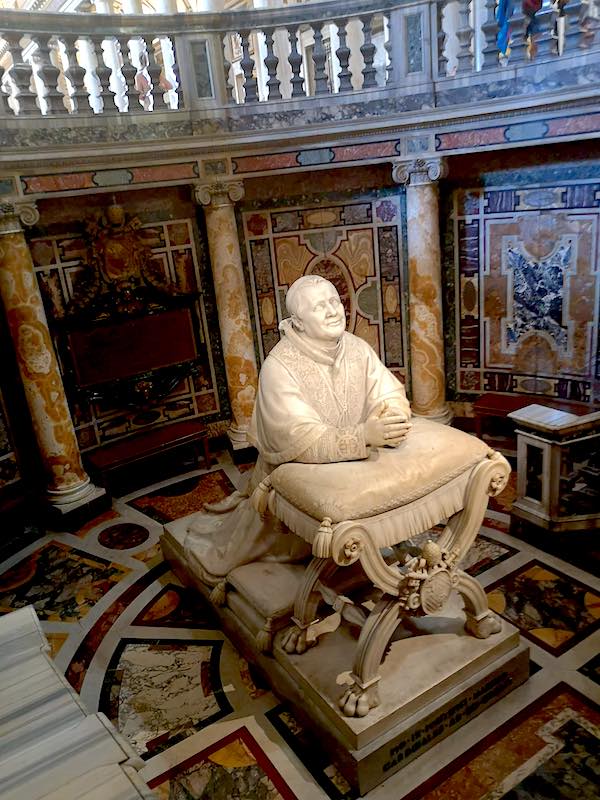
In this same area, we can also see the tomb of Gian Lorenzo Bernini, an exceptionally prolific artist in Rome and whose remains are here.
The Sistine Chapel of St Mary Major
Santa Maria Maggiore has its very own Sistine Chapel (the most famous one is in the Vatican), a side chapel that takes its name from Pope Sixtus V (1585-1590), who restored the church.
The Pope wanted to chapel to host the sacred grotto by Arnolfo di Cambio: while the grotto is now in the church museum, the chapel is striking and worth seeing for its elaborate decorations.
The Paolina Chapel
Another important side chapel inside St. Mary Major is Cappella Paolina, which owes its name to Pope Paul V (1605-1621).

The Pope wanted the chapel to host the icon of Salus Populi Romani currently on top of the main altar.
Worth noticing is the sculpture at the very top, by Maderno, representing Pope Liborius marking the church’s perimeter on the ground before its construction.
Several masters worked at this chapel including Cavalier d’Arpino, Baglione, Guido Reni, Ludovico Cardi detto il Cigoli and Bernini father.
The chapel host impressive tombs of several Popes, marked by impressive statues.
The Sforza Chapel
The Sforza chapel was commissioned to Michelangelo and Vasari talks of drawings of it by Michelangelo. Finally, however, the chapel was realized by Dalla Porta and Calcagni, to whom we owe the chapel as we see it now.
Legends about Santa Maria Maggiore
Santa Maria Maggiore is at the center of several legends.
The first, which we already mentioned above, is the lost girl who found her way back to safety thanks to the church bells ringing after her prayers to the Virgin.
The other legend is the miracle of the snow, and it is still celebrated today.
The legends say that on 5 August 352 AD, Pope Liborius had a dream.
The Virgin appeared to him and asked to build a church in a location of her choice.
The morning after that dream, snow fell on top of Esquiline Hill, and the Pope immediately identified it as a sign of her chosen spot.
This miracle gets re-enacted regularly each august with a special celebration in the basilica.
What to see nearby
Santa Maria Maggiore is close to:
Rione Monti – stunning, historical area of Rome City Center, with great charm and buzzy atmospheres
Santa Prassede – fantastic paleo-Christian church with unique mosaics in the famous Chapel of St Zeno
The Arch of Gallienus – one of the most impressive ancient arches in Rome
The Baths of Diocletian – breathtaking ruins of ancient Roman Baths
Palazzo Massimo alle Terme – one of the best museums in Rome, preserving frescoes from the house of Livia (wife of Emperor Augustus)
Close to Santa Maria Maggiore you also find Termini Station, Via Cavour and Via Nazionale, main transport and shopping hubs in Rome City Center.
The church is also close to Piazza della Repubblica and the church of Santa Maria degli Angeli e dei Martiri, designer by Michelangelo
I hope you enjoyed this quick visitors’ guide to the Basilica of Santa Maria Maggiore and it helped you plan your visit. Safe travels to Rome!
Basilica of Santa Maria Maggiore – pin this!

